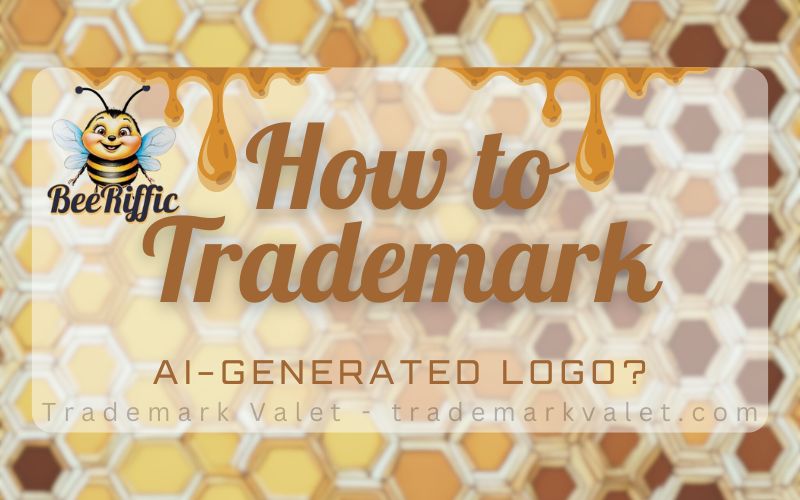
How to Trademark an AI-Generated Logo? What You Need to Know
Read Time: 15 minutes
Want to trademark your AI-generated logo but don’t know where to start? You’re not alone. Many business owners ask us if they can trademark AI logos, sell them, or how to begin the process. The good news is, yes, you can trademark an AI logo, and today creating one is easier than ever.
With AI (artificial intelligence) quickly advancing, you can now create a logo design for your business. You can have AI generate a logo in minutes that once took designers weeks to create. Platforms like Canva’s Dream Lab make designing quick and fun. However, getting the logo is the easy part, but exactly how do you go about protecting it? That’s where proper trademark knowledge becomes important.
Before you jump into AI logo creation, let’s cover the basics on how to create and protect your new AI logo. We will explain everything about trademarking your AI-generated logo. We’ll also cover choosing the right AI tools, getting proper documentation, and filing with the USPTO.
Ready to protect your brand? Let’s begin!
Can I Trademark an AI-Generated Image Logo?
Yes, you can trademark an AI-generated logo! The United States Patent and Trademark Office (USPTO) doesn’t care whether a human or AI created your logo. What matters is how you use the logo.
Many worry that AI-made logos can’t be trademarked. This isn’t true! The trademark office focuses on how you use the logo to represent your business, not how you created it.
To successfully trademark an AI-generated logo design, you need to meet these basic requirements. Such as:
- The logo needs to be distinct and not mistaken for another trademark.
- You need to use the logo in commerce (like on products or services).
- The logo should identify your business clearly.
- You must have proper rights to use the logo.
However, before applying for a trademark, check your AI logo creator’s terms. Some AI tools give you full commercial rights, while others might limit what you can do with the logo they generate.
Therefore, the key is making sure you have the right license from your AI logo generator. Save all documents that show you have permission to use and trademark the logo. For example:
- Download a copy of the AI platform’s terms of service for your records.
- Keep your purchase receipt showing you bought the commercial rights.
- Save the commercial use license in a safe digital folder.
- Store any specific trademark rights documentation the platform provides.
These documents are important proof showing you have legal rights to trademark the logo. Keep them safe! You’ll need them when applying for trademark protection.
Where to Find AI Logo Generators with License to Trademark?
Yes, there are many AI logo generators with licenses to trademark that offer full ownership rights. These software tools can be found using a search engine. Here is a short list of companies we found asking ChatGPT.
- Looka provides full commercial rights and allows trademark registration with their premium package.
- Ucraft offers unrestricted commercial use rights with exportable PNG and SVG formats suitable for trademark applications.
- Sologo AI includes complete ownership transfer, enabling both commercial use and trademark registration.
When looking for an AI logo generator, be sure they have full commercial use rights that support trademark registration. When choosing an AI logo generator, focus on platforms that clearly state their ownership transfer terms. This is important to protect your intellectual property rights.
A generative AI logo maker is valuable only when it provides complete commercial and full ownership rights. Which leads to finding the right company to save you time and legal headaches later.
Many people don’t realize how important these rights are until it’s too late. Therefore, before choosing an AI logo generator, be sure that you understand their license terms. Without proper licensing rights, your business will face serious risks. Such as:
- You might waste money on a logo you can’t legally protect.
- Other businesses could use the same design.
- You could face legal issues when trying to trademark a logo that is already in use.
- You may need a new logo if the license doesn’t allow trademarking.
Before moving forward with a company, ensure there are no hidden terms and no confusing legal language. Look for straightforward ownership in their pricing plan or license terms. We will use Canva as an example to provide you step-by-step instructions on how to use an AI logo creator.
Can I Trademark a Logo from Canva?
Yes, you can trademark a logo from Canva. Their AI logo generator powered by Dream Lab lets you create and trademark unique business logos. The tool turns your text descriptions into custom designs, though finding the perfect look might take several tries.
Think of it like working with a designer who needs clear direction. The better you describe what you want, the closer you’ll get to your ideal logo. To get the most out of Dream Lab, use AI tools like Claude or ChatGPT to help create AI logo design prompts.
Practicing and rewording the text helps Dream Lab generate logos that match your brand’s vision. Below is a basic sample on how to begin.
Let’s begin on how to use the AI image logo generator in Canva Pro.
Visit the Canva free AI logo generator and click “Create a logo with AI” by Dream Lab.
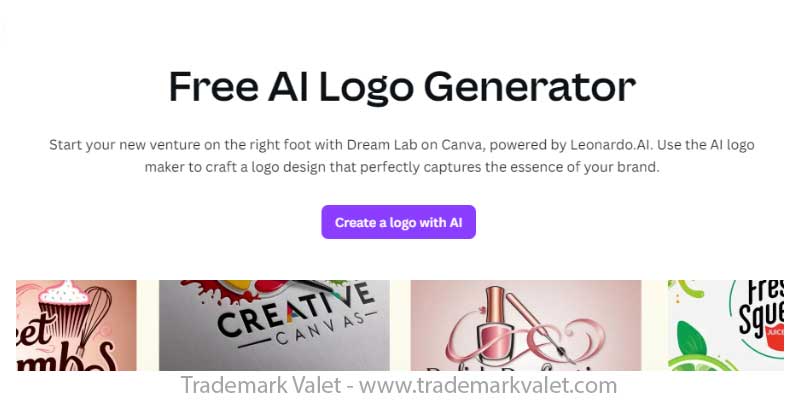
Type what you want your logo to look like. We typed, “Create a cute animated bee that is smiling on a white background.” Below are the results.
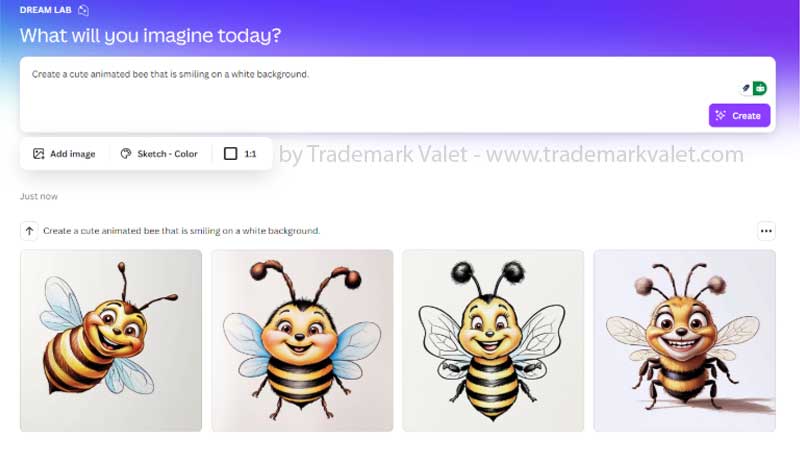
Once you have the design you like, then hover over the image to edit it. With the Pro version, you can finish creating your logo to be trademarked.
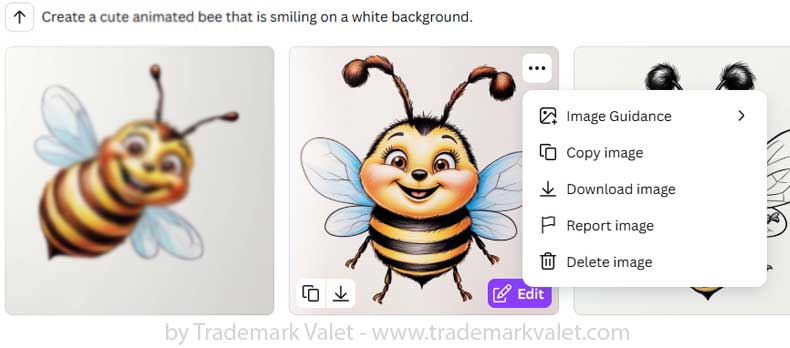
We kept a copy of the original AI logo. We then removed the background and used the Magic Grab to move the legs. To add the final touch, we chose the TypeExtrude addon for the font look.
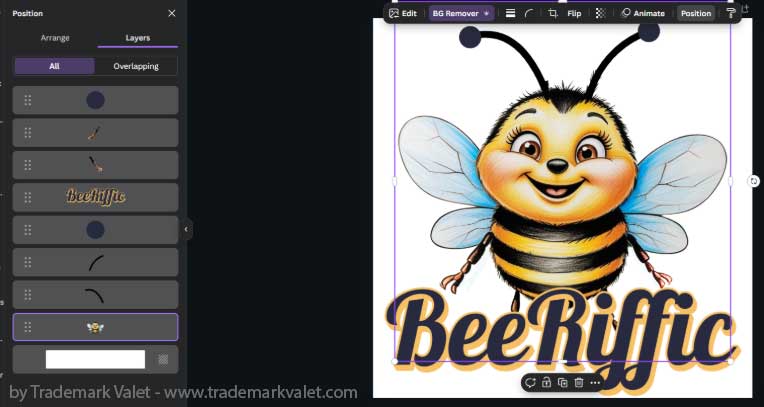
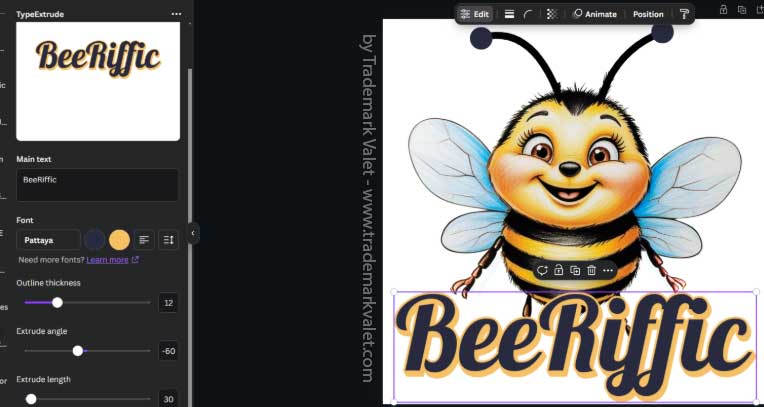
The final logo we chose to trademark. You can trademark your logo yourself, or Trademark Valet can help you trademark your logo.

Remember, Canva’s free version does not allow you to use the logo for commercial purposes. You will need to purchase Canva Pro or Enterprise to get the full commercial rights. The free plan doesn’t include trademark rights for AI-generated logos.
Also, we recommend reading the license terms for using Dream Lab before creating an AI logo. We always advise that you read all terms and conditions before using any AI-powered tools.
Other AI Logo Generators
While several AI platforms claim to create logos, not all offer clear trademark rights. Let’s explore popular AI tools that many people ask about for logo creation. Understanding their capabilities and limitations helps you make informed decisions for your business branding.
Some of these tools work differently than dedicated AI logo generators. They might create interesting designs but lack important features like commercial licensing or file formats needed for professional use.
Can I create a logo with Midjourney?
Yes, you can create logos with Midjourney, but trademarking them is complicated. Their terms grant you commercial rights to AI-generated images, including logos.
However, Midjourney doesn’t provide vector files needed for professional logo use. You’ll need additional design work to make their outputs trademark-ready. You can read more about their terms and service or reach out to us for further help.
Can Claude.ai Create Logos for Trademarking?
No, Claude.ai cannot directly create visual content such as logos. It specializes in text-based tasks that can help in a variety of ways to facilitate the creation of a trademarkable logo.
Can ChatGPT create a business logo to Trademark?
No, ChatGPT cannot directly create a logo. It can help you design a concept or guide you through the process of creating a logo that you can trademark.
Is it legal to sell AI-generated logos?
Yes, selling AI-generated logos is legal when you have proper commercial rights from the AI platform. The platform’s terms of service must allow commercial use, and you need to purchase the appropriate licensing level.
Most importantly, ensure the logo doesn’t infringe on existing trademarks. Keep all documentation showing your ownership rights for legal protection.
Who owns the AI logo?
Ownership of an AI-generated logo depends on your agreement with the AI platform. Most commercial AI logo generators transfer full ownership rights to you after purchase, especially with premium packages.
However, some platforms may retain partial rights or require attribution. Free AI tools typically limit commercial usage, so always read the terms carefully and get written confirmation of rights transfer.
The key is understanding what rights you’re buying. Think of it like purchasing a house; you need proper documentation proving you own it. When you buy commercial rights for an AI-generated logo, you’re purchasing the right to use, sell, and trademark that design for your business.
How to Register a Logo for a Trademark?
Understanding how to register a logo for a trademark protects your business identity from copycats and competitors. Without proper trademark registration, other companies could use a similar logo and confuse your customers.
A registered trademark gives you legal ownership of your logo nationwide. This means you can take legal action if someone copies your design. It also proves you own the logo if someone challenges your right to use it.
Think of trademark registration like a fence around your brand. It keeps others from using your logo, building trust with customers who recognize your business. For online businesses, trademark protection is especially important since your logo appears on websites and social media.
Below are some basic steps to get you started registering your trademark.
Basic Steps on How to Register Logo Trademark – USPTO
- Conduct a Trademark Search
- Search the USPTO’s Trademark Electronic Search System (TESS) database to ensure your logo isn’t already registered.
- Consider searching state trademark databases and common law uses through general internet searches.
- Document your search results for future reference.
- Prepare Your Logo Files
- Create a clear, high-quality digital version of your logo.
- Save it in multiple formats (JPG, PNG, vector files).
- Keep a record of colors (including specific color codes within your logo).
- Determine Your Filing Basis
- Choose “Use in Commerce” for Use-Based Applications (Section 1(a)). This is evidence that the logo is already being used in commerce (e.g., product packaging, labels, and website screenshots showing the logo next to goods or services).
- Choose “Intent to Use” for Intent-to-Use Applications (Section 1(b)). You’ll submit a specimen later when filing the Statement of Use or Amendment to Allege Use.
- Access the USPTO’s TEAS System
- Go to the USPTO website (www.uspto.gov).
- Select “File a Trademark” through the Trademark Electronic Application System (TEAS).
- Choose between TEAS Plus ($250 per class) or TEAS Standard ($350 per class).
- Complete the Application
- Enter your contact information.
- Upload your logo image.
- Select appropriate international classes for your goods/services.
- Describe your goods/services specifically.
- Provide specimens if filing under “Use in Commerce.”
- Pay the required fees.
- Monitor Your Application
- Note your serial number for future reference.
- Check status through the Trademark Status & Document Retrieval (TSDR) system.
- Respond to any Office Actions within 6 months if received.
- Set up alerts or calendar reminders for deadlines.
Important Tips:
- Keep detailed records of first-use dates.
- Save all correspondence from USPTO.
- Budget for both initial and maintenance fees.
- Plan for the process to take 8-12 months.
Remember that this is a general guide, and specific requirements may vary based on your situation and jurisdiction. If you need legal advice, we suggest reaching out to a trademark attorney.
We can help you with the classifications, descriptions, or any legal implications concerning your AI-generated trademark. We can also help with any legal pitfalls you may encounter.
How to Check if My Logo is Trademarked?
Finding out if your logo is trademarked helps prevent trademark infringement and legal requirements. Taking proactive measures to search existing trademarks protects your business from costly mistakes.
Start with the USPTO’s trademark database at USPTO.gov. This free tool shows active trademarks and pending applications. Search by design elements, words, and business types. Many trademark owners register similar versions of their logos, so check thoroughly.
At Trademark Valet, Brandon Leavitt, an experienced trademark attorney, can perform a comprehensive search for you. With over 20 years of experience in trademark law, our legal team understands the complexities of trademark ownership.
We check federal, state, and common law databases to ensure your logo doesn’t conflict with existing trademarks. Our firm’s expertise helps protect your business from potential legal challenges while saving you time and effort.
Trademark ownership search matters because similar logos in the same industry can cause confusion among consumers. Even if a logo isn’t registered, someone using it first may have rights under trademark law.
How Long Does it Take to Trademark an AI Logo?
The trademark process for an AI logo typically takes 9-12 months through the USPTO. This timeline starts from your application date and includes several review stages.
First, the USPTO reviews your application within 3-4 months. If approved, your logo enters a 30-day opposition period where others can challenge it. Without objections, registration completes in about 6 more months.
Several issues can extend your timeline:
- The USPTO found problems with your application documents.
- Your logo conflicts with an existing trademark.
- Another business filed an opposition claim.
- Your file is missing required information.
You can use the ™ symbol while waiting for approval. Once registered, you can switch to the ® symbol, showing full trademark protection.
Can Multiple Businesses Use the Same AI-Generated Logo?
No, multiple businesses should not use the same AI-generated logo, even if it comes from the same platform. Each business needs a unique logo to prevent consumer confusion and trademark conflicts.
While AI platforms can create similar designs, using identical logos creates legal risks:
- Your trademark application may be rejected.
- You could face trademark infringement claims.
- Risk of consumer confusion between the businesses.
- Your brand loses its unique identity.
If you discover another business using the same AI-generated logo, take these steps:
- Document when you first used the logo.
- Save your AI platform purchase records.
- Contact the other business professionally.
- Consider trademark registration quickly.
Can AI-Generated Logos Be Modified for Trademark Protection?
Yes, AI-generated logos can and often should be modified for better trademark protection. Making unique changes helps distinguish your logo from similar AI-created designs. Working with a professional designer to customize your AI-generated logo creates a more distinct brand identity.
Consider changing colors, adjusting typography, or adding custom elements that reflect your business values. These modifications make your logo more unique while maintaining the original design’s appeal. Save all modification records and original AI files to document your ownership of the design process.
Professional customization strengthens your trademark application by setting your logo apart from other AI-generated designs. This investment increases your chances of trademark approval and helps build a memorable brand identity.
Are AI-Generated Images Copyrighted?
No, AI-generated images currently cannot be copyrighted in the United States. The U.S. Copyright Office states that copyright protection only extends to works created by humans, not artificial intelligence.
Therefore, it must have a human creator, involve human authorship, and be the original creation to file a copyright registration. All AI-generated artwork or any AI-generated content will not be protected under copyright law. This includes any AI-generated material or AI-generated creations, as they lack the required elements of authorship.
What Does Copyright Mean?
Copyright law protects original creations made by human creators. It gives human authors exclusive rights to control how their original creation is used. Copyright protection starts immediately when someone creates an original work. Which is why human-made work can obtain a copyright over AI-created artwork.
While not required, copyright registration offers extra legal protection and benefits for copyright owners. The copyright owner of original content receives artistic copyright protection against copyright infringement.
Why can’t I Copyright an AI Generated Image or Logo?
AI-generated artwork lacks the required human authorship for copyright protection. While AI can create impressive designs, copyright law specifically requires a human creator. The U.S. Copyright Office has made it clear that AI-generated content cannot receive copyright registration.
This raises intellectual property issues since any AI-created artwork from an image generator has non-human authorship, making it ineligible for copyright claims.
What’s the Difference Between Copyright and Trademark for AI Logos?
While copyright law doesn’t protect AI-generated content, trademark law focuses on business identity rather than human authorship. Your AI-generated logo can be trademarked because trademarks protect how businesses use marks in commerce, regardless of their original creation method.
This resolves many legal questions and copyright issues around copyright ownership and copyright eligibility for business identifiers.
Final Thoughts About Trademarking an AI-Generated Logo
Trademarking an AI-generated logo protects your business identity in today’s digital world. While AI makes logo creation faster and cheaper, proper trademark registration remains essential for long-term brand protection.
The future of AI-generated logos looks promising. As technology advances, more businesses will use AI tools for branding. However, trademark protection will always be crucial for building a strong, legally protected brand identity.
We can help you with any stage of the trademark application process. If you are ready to hire us, we offer a free one-time consultation to help you begin. If you want answers only, no problem; we offer a low rate of $99 for 30 minutes.
Faq’s
Can you trademark an AI-generated logo?
Yes, you can trademark an AI-generated logo. The USPTO trademark requirements don’t specifically exclude AI-created designs. What matters is that you have proper commercial rights to the logo and use it to identify your business in commerce. Please ensure that your AI logo platform offers clear ownership terms in its licensing agreement.
Can I trademark my logo myself?
Yes, you can trademark your logo by filing a trademark application through the USPTO website. However, consider hiring an attorney for complex cases to avoid costly mistakes.
How to trademark a logo for free?
You cannot trademark a logo for free. USPTO fees start at $250 per class. However, you can use the ™ symbol without registration while building trademark rights through use.
Can AI Generate Logos?
Yes, AI platforms can create unique logos using text prompts. Popular tools include Midjourney, Canva’s AI generator, and specialized AI logo makers. Each platform offers different features and licensing rights.

Thank you for getting to the point and explaining this clearly. This really helped a lot.
Thank you for your comment. Glad we could help you out.